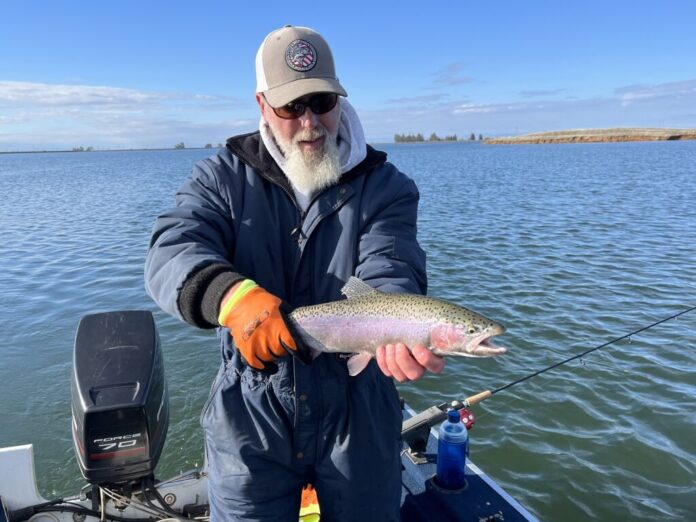As we head into winter a couple of weeks from now, hopefully we will be dealing with lots of precipitation. Knowing a bit about the geography surrounding some of our local waters could help in finding good places to fish.
Once the ground is saturated, heavy rains will tend to muddy up local rivers and lakes. The lake that comes to mind first is Collins Lake at the 1200′ elevation. The creek feeding Collins is typically below the snow line and a heavy rain will turn the lake brown in a day or two.
The Lower Yuba River is fed by many local streams and it can be “blown out” with a series of heavy rain storms. The Yuba does not have a big reservoir at the confluence of its many forks. Englebright at this position holds back a small volume and doesn’t keep the turbid water from the downstream river for long.
Photo by Denis Peirce
The opposite is true for the Feather River. Lake Oroville, just above the valley floor, holds an incredible amount of water. It is common knowledge among winter steelhead anglers that the last river to get “blown out” is the Feather River near Oroville. The Sacramento, Yuba and America Rivers will look like chocolate milk and the Feather can be in great shape, for a while. Yes, with the right conditions even Oroville can get muddy brown.
The water from Lake Oroville is split between the original river channel and the Thermolito Complex. The original river channel typically runs at 600 cfs through the town of Oroville. The rest of the flow is diverted into the Thermolito Forebay and then the Afterbay. The Afterbay feeds water into irrigation canals and also back into the river channel.
The Afterbay can be a terrific trout fishery depending on the year. Each year in January the Feather River Hatchery spawns their annual steelhead run. The previous year’s fish are then planted in the Feather River usually in early February. The goal is to put 450,000 juveniles into the river and if there are surplus fish, they then plant the Afterbay. Many years there are up to 50,000 6 to 8 inch steelhead/rainbow trout planted.
The Afterbay is a 10,000 acre shallow lake. A deep spot is only 20′. It is meant in part as a warming basin for the very cold water from the bottom of Lake Oroville. In the summer the inflow to the Afterbay can be in the low 50’s. The outflow temps can be in the 60’s and 70’s. In the hot weather months the best trout fishing is near the inlet. During the cool months the fish are scattered.
Photo by Denis Peirce
This week I fished the Afterbay for the first time in over 10 years. I spent the day on the water with guide Shawn Rainsbarger trying to figure out this fishery. The water temperature was 50 to 51 degrees. The water was green with 5 feet of visibility. It was the first day after a storm which meant a rising barometer, not ideal. We did land three nice rainbow trout/steelhead. The largest was a respectable 22 inches. The Afterbay has a minnow population of pond smelt which originated from the lake above. The first trout hit a white trolling fly near the surface not 100 yards from the launch ramp. Other colors that worked were dark brown and a rust colored tube fly.
One notable aspect to these fish was that they all hit hard, bending the rods nicely. Then they ran towards the boat so rapidly that I questioned whether we still had the fish on. Once they saw the boat they jumped and pulled hard. All three fish fought the same way.
There was only one other trout fishing boat on the lake that day along with some shore anglers fishing the in-flowing canal.
There were duck hunters out in the early morning. If you are an unattached duck hunter with a boat, the Afterbay might be a place to try.
Photo by Denis Peirce
Oroville is an hour’s drive, 55 miles, from Penn Valley. With no launch fee the Afterbay is an alternative to some of the closer lakes to home. To get there go west on Highway 62 from Oroville a few miles. There are two launch ramps along the highway, one on either side of the road.
The Afterbay is open from sunrise to sunset. The quality of the rainbow trout is well above average. It is worth the drive to fish here for a day.
Denis Peirce writes a fishing column for The Union’s Outdoors section and is host of “The KNCO Fishing & Outdoor Report,” which airs 6-7 p.m. Fridays and 5-6 a.m. Saturdays on 830-AM radio. Contact him via his website at http://www.trollingflies.com
Photo by Denis Peirce
Credit: Source link































